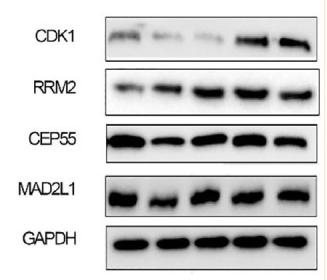RRM2 Antibody - #DF7248
| Product: | RRM2 Antibody |
| Catalog: | DF7248 |
| Description: | Rabbit polyclonal antibody to RRM2 |
| Application: | WB IHC |
| Cited expt.: | WB |
| Reactivity: | Human, Mouse, Rat |
| Prediction: | Bovine, Horse, Chicken |
| Mol.Wt.: | 45kDa; 45kD(Calculated). |
| Uniprot: | P31350 |
| RRID: | AB_2839187 |
Related Downloads
Protocols
Product Info
*The optimal dilutions should be determined by the end user. For optimal experimental results, antibody reuse is not recommended.
*Tips:
WB: For western blot detection of denatured protein samples. IHC: For immunohistochemical detection of paraffin sections (IHC-p) or frozen sections (IHC-f) of tissue samples. IF/ICC: For immunofluorescence detection of cell samples. ELISA(peptide): For ELISA detection of antigenic peptide.
Cite Format: Affinity Biosciences Cat# DF7248, RRID:AB_2839187.
Fold/Unfold
cb111; chunp6884; etID309896.20; R2; reductase M2 polypeptide variant 1; reductase M2 polypeptide variant 2; reductase M2 polypeptide variant 3a; reductase M2 polypeptide variant 3b; reductase M2 polypeptide variant 3c; reductase M2 polypeptide variant 3d; Ribonucleoside-diphosphate reductase subunit M2; Ribonucleotide reductase M2; Ribonucleotide reductase M2 polypeptide; Ribonucleotide reductase M2 subunit; ribonucleotide reductase protein r2 class I; Ribonucleotide reductase regulatory subunit M2; Ribonucleotide reductase small chain; Ribonucleotide reductase small subunit; Ribonucleotide reductase, R2 subunit; RIR2_HUMAN; RR2; RR2M; RRM2;
Immunogens
A synthesized peptide derived from human RRM2, corresponding to a region within C-terminal amino acids.
- P31350 RIR2_HUMAN:
- Protein BLAST With
- NCBI/
- ExPASy/
- Uniprot
MLSLRVPLAPITDPQQLQLSPLKGLSLVDKENTPPALSGTRVLASKTARRIFQEPTEPKTKAAAPGVEDEPLLRENPRRFVIFPIEYHDIWQMYKKAEASFWTAEEVDLSKDIQHWESLKPEERYFISHVLAFFAASDGIVNENLVERFSQEVQITEARCFYGFQIAMENIHSEMYSLLIDTYIKDPKEREFLFNAIETMPCVKKKADWALRWIGDKEATYGERVVAFAAVEGIFFSGSFASIFWLKKRGLMPGLTFSNELISRDEGLHCDFACLMFKHLVHKPSEERVREIIINAVRIEQEFLTEALPVKLIGMNCTLMKQYIEFVADRLMLELGFSKVFRVENPFDFMENISLEGKTNFFEKRVGEYQRMGVMSSPTENSFTLDADF
Predictions
Score>80(red) has high confidence and is suggested to be used for WB detection. *The prediction model is mainly based on the alignment of immunogen sequences, the results are for reference only, not as the basis of quality assurance.
High(score>80) Medium(80>score>50) Low(score<50) No confidence
Research Backgrounds
Provides the precursors necessary for DNA synthesis. Catalyzes the biosynthesis of deoxyribonucleotides from the corresponding ribonucleotides. Inhibits Wnt signaling.
Phosphorylation on Ser-20 relieves the inhibitory effect on Wnt signaling.
Cytoplasm.
Belongs to the ribonucleoside diphosphate reductase small chain family.
Research Fields
· Cellular Processes > Cell growth and death > p53 signaling pathway. (View pathway)
· Metabolism > Nucleotide metabolism > Purine metabolism.
· Metabolism > Nucleotide metabolism > Pyrimidine metabolism.
· Metabolism > Metabolism of other amino acids > Glutathione metabolism.
· Metabolism > Xenobiotics biodegradation and metabolism > Drug metabolism - other enzymes.
· Metabolism > Global and overview maps > Metabolic pathways.
References
Application: WB Species: Rat Sample:
Application: WB Species: Human Sample: breast cancer tissue
Restrictive clause
Affinity Biosciences tests all products strictly. Citations are provided as a resource for additional applications that have not been validated by Affinity Biosciences. Please choose the appropriate format for each application and consult Materials and Methods sections for additional details about the use of any product in these publications.
For Research Use Only.
Not for use in diagnostic or therapeutic procedures. Not for resale. Not for distribution without written consent. Affinity Biosciences will not be held responsible for patent infringement or other violations that may occur with the use of our products. Affinity Biosciences, Affinity Biosciences Logo and all other trademarks are the property of Affinity Biosciences LTD.





